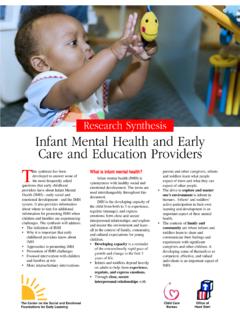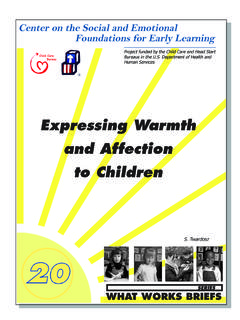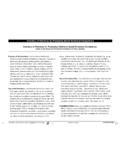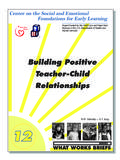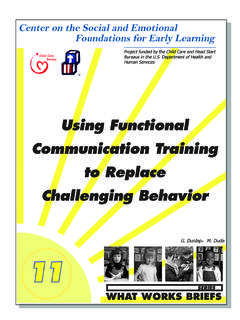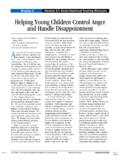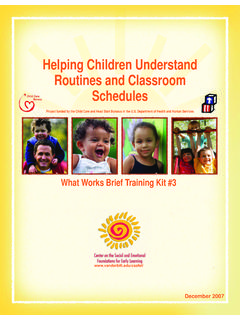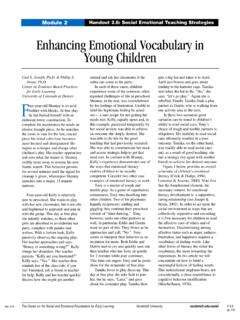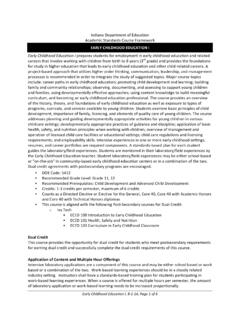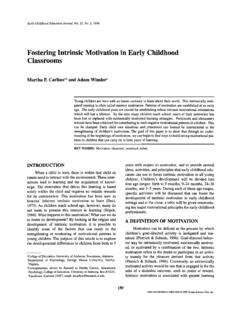Transcription of Helping Children Understand Routines and Classroom …
1 Center on the Social and EmotionalFoundations for early LearningProject funded by the Child Care and Head Start Bureaus in the Department of Health and Human ServicesSERIESWHAT WORKS BRIEFS3M. M. Ostrosky E. Y. Jung M. L. Hemmeter D. ThomasHelping Children Understand Routines and Classroom SchedulesThis What Works Brief is part of a continuing series of short,easy-to-read, how to information packets on a variety ofevidence-based practices, strategies, and interventionprocedures. The Briefs are designed to help teacherssupport young Children s social and emotional include examples and vignettes that illustrate howpractical strategies might be used in a variety of earlychildhood settings and home Rashid hid her nervousness as she smoothed down her sweater and entered the room. This was her first day working ina Head Start and child care facility located in a large metropolitan city, and she wondered if she was up to the job.
2 Theoriginal teacher had left suddenly, and Mrs. Rashid found herself feeling unprepared. She and the assistant teacher, Mrs. Johnson,had met the week before to plan and had made a few home visits to meet the Children , but they had not had time to visit all of thehomes. Mrs. Rashid had just graduated with a degree in elementary education, and she worried whether her college courses hadtruly prepared her for a Classroom full of preschoolers! One hour later, she again doubted herself as she came face to face with anoisy group of 3- and 4-year-olds, all competing for her attention. Gathering up her courage, and recalling the carefully plannedmorning, Mrs. Rashid squared her shoulders, enthusiastically smiled at the group, and began to learn names, nicknames, andunusual stories from each child. By the end of the morning, both teachers were exhausted from meeting the demands of thechildren.
3 As they sat in their chairs reflecting on the morning and planning for the next day, both wondered how they wouldhandle Marcus, a boisterous Are Schedules and Routines ?Scheduling refers to deciding who will do what and when theywill do it. A consistently followed schedule helps make settingspredictable for both young Children and adults. Routines areevents that are completed on a regular basis, frequently involv-ing a series of responses. Examples include the Routines fol-lowed when Children prepare for a nap ( , go potty, gather cotand blanket, take off shoes, lay on cot with blanket, and listen tomusic) or the Routines in place when a group of Children prepareto hear an adult read a the middle of the next morning, Mrs. Rashid decidedthat she had already used all she had learned in hercollege courses about Children s behavior!
4 She sighed asshe watched Marcus bump into a quiet little girl in thedramatic play center. As she picked up the child, s eyes followed Marcus as he ran around the room,pretending to be an airline pilot. She watched helplessly asother Children began to run around the room, following hisexample. Mrs. Rashid felt powerless as she planned for thenext day, wondering what she and Mrs. Johnson couldpossibly do to help improve the Classroom planning activity schedules and Classroom or homeroutines, caregivers should consider the following factors: thebalance of activities, the tempo or pace of activities, youngchildren s attention span, when Children are most alert, thenumber of adults available, other things happening in theclassroom ( , one child may be receiving speech therapy), andthe fact that longer play periods result in higher levels of addition, adults can arrange concurrent activity schedules ( ,two or more optional activities at the same time) to providechoices for Children .
5 For example, young Children might be ableto select from the following centers during a given one-hourblock of time each day: art, blocks, housekeeping, book/musiccorner, or snack the beginning of the year, adults can teach Children routinesby using picture and object schedules. They can post theseschedules in order for Children to become familiar with them andbecome more independent. If changes are to occur in theschedules, caregivers should review the changes at the beginningof the day to help Children feel secure and Understand theexpectations of their Rashid and Mrs. Johnson decided they needed to pay closer attention to their class schedule. Both recalled fromprevious training and courses that it was important to consider the physical and emotional environment, as well as thechildren s Routines .
6 They wondered if making some changes to the schedule would help Marcus, as well as the rest of the current schedule consisted of a fairly long circle time at the start of the day, followed by an extended free play time through-out the morning. Children were allowed to wander from center to center as they wanted. In order to facilitate?? the Children sinterest, the first thing Mrs. Rashid did was to shorten circle time and incorporate more activities for the Children to do, ratherthan simply having them??listening to her read a book. For example, she sang songs while the Children clapped along, did handmovements, or played musical instruments. The second thing she did was to better organize free play by establishing some rulesfor the centers ( , limiting the number of Children in each center). The teachers set up a basic class schedule with picturesrepresenting activities and centers, which allowed the Children to visit three centers during a specific time period during themorning, based on their interest level.
7 Mrs. Rashid and Mrs. Johnson still felt that several of the Children , including Marcus,needed a little more structure to help them throughout the day. During much of the time, Marcus ran from center to center,knocking things over. Marcus also lost his temper frequently. In order to meet his need for more structure, Mrs. Rashid helpedMarcus with an individualized picture schedule, utilizing things that interested him such as his love of books, blocks, and artactivities. It was important that Marcus have the structure that he needed but, at the same time, recognize that he had choices andoptions. Both teachers took turns working with him each morning to go over the class schedule and choose his activities for theday, reminding him that he would have many opportunities to do the things he wanted and play with the toys he desired.
8 Hisschedule was posted in a special place near his cubby at eye level for him to refer to throughout the Are Schedules and RoutinesImportant?Studies have documented that schedules and Routines influencechildren s emotional, cognitive, and social development. Forexample, predictable and consistent schedules in preschoolclassrooms help Children feel secure and comfortable. Also,schedules and Routines help Children Understand the expectationsof the environment and reduce the frequency of behaviorproblems, such as tantrums and acts of aggression. Activityschedules that give Children choices, balanced and plannedactivities (small vs. large groups, quiet times vs. active times,teacher directed vs. child directed, indoor vs. outdoor), andindividualized activities result in a high rate of child engage-ment.
9 In addition, the duration of the play period can affectchildren s social and cognitive forms of play (a play period thatis longer than 30 minutes leads to higher levels of social andcognitive play). early one morning, about two weeks after the teachersindividualized his schedule, Marcus ran to his cubby,looking eagerly for his schedule. He took the bright orangepaper down from his cubby and ran over to Mrs. , he sat down with her and reviewed the schedule forthat day, choosing the centers he wanted to visit later in themorning. Mrs. Rashid smiled, realizing that, while thisstrategy? did not completely solve his behavior issues, it didprovide him with several things. First, Marcus met with Teacher at least once a day, which he enjoyed! Second,he got the chance to choose which centers he would visitduring the morning, a skill?
10 ? that enabled him to be moreindependent. Third, it helped him Understand that his time atHead Start included special and fun activities. Marcuscontinued to be unpredictable at times, but both teachersfound that talking with Marcus about his schedule helpedhim realize that every day held a certain routine. If therewere changes, Mrs. Rashid and Mrs. Johnson would helphim with the change. The day held a certain predictabilityand consistency, which helped Marcus anticipate whatwould happen Are the Children Who HaveParticipated in Research on Schedules andRoutines?Research on schedules and Routines has been conducted with alimited group of Children in child care settings, inclusivepreschools, university preschools, and a state psychiatricinstitute. When designing schedules and Routines , teachers willwant to try to meet the cultural, linguistic, and individual needsof the Children in their care.
